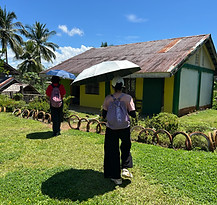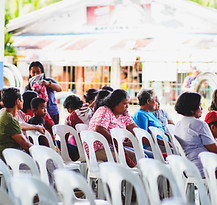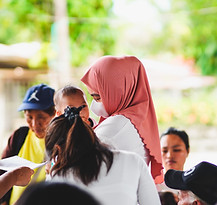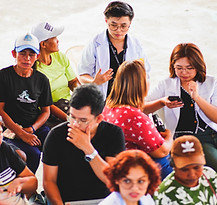
IDENTIFIED HEALTH PROBLEMS
Prevalence of Hypertension
1

CUES
-
Hypertension ranked as the top morbidity case in Barangay Gaulan from 2022 to 2024, with 81 cases recorded in 2022, 57 cases in 2023, and 64 cases in 2024.
-
A total of 178 individuals aged 40 years old and above were not screened for blood pressure due to absence or access limitations.
-
Among the screened residents aged 40 years old and above, 55% were identified to have elevated blood pressure levels: 59 individuals were classified as pre-hypertensive, 31 as Stage I hypertensive, and 17 as Stage II hypertensive, while 87 individuals had normal blood pressure readings.
-
60.4% of surveyed households reported no member having regular annual health check-ups, indicating low health-seeking behavior.
-
50% of residents reported difficulty in affording medications and consultations, with an additional 7.3% lacking access to medicine and medical consultation entirely.
-
The barangay shows a notable prevalence of overweight and obesity, with 98 cases recorded in 2022, 80 in 2023, and 51 in 2024, indicating poor dietary and lifestyle practices.
-
Lifestyle-related risk behaviors remain prevalent, with 24 identified current smokers and 25 binge drinkers as of 2024.
-
82.6% of households in Barangay Gaulan fall below the poverty threshold, affecting access to nutritious food, healthcare services, and personal medical devices like BP monitors.
Prevalence of Diabetes
2

CUES
-
30.0% increase in the number of identified Diabetic individuals from 2022 to 2023.
-
15.4% increase in the number of identified Diabetic individuals from 2023 to 2024.
-
Diabetes Mellitus (Type I and II) has consistently rank in the Top 5 of the 10 leading morbidities in Barangay Gaulan from 2022 to 2024.
-
5.9% of the households prefer herbal remedies over conventional treatment.
-
60.4% of the households does not practice regular check-ups (less than once annually).
-
42.7% of the household report difficulty accessing medication; 7.3% have no access at all
Improper
Solid Waste Management
3

CUES
-
79.9% (n = 230) of 288 households use sacks for waste storage as their waste bin.
-
25.3% (n = 73) of 288 households do not practice proper waste segregation.
-
68.4% (n = 197) of 288 households are not covered or do not have regular service by barangay waste collection.
-
43.1% (n = 124) of 288 households burn their trash, posing environmental and health risks
-
Recycling is practiced by only 2.1% (n = 6) of 288 households, showing very low community engagement in waste recovery.
Animal
Bites
4

CUES
-
Data from 2024 indicate a significant 34.5% increase in the incidence of reported animal bites.
-
Animal bites have consistently ranked among the top 10 leading causes of morbidity in Barangay Gaulan from 2022 to 2024.
-
From the ocular and primary survey, most households own unvaccinated pets such as dogs, cats, and monkeys which increases the risk of rabies transmission following a bite.
Prevalence of Malnutrition
5

CUES
-
2.3% of the individuals under 5 were classified as obese and 0.8% were wasted during 2022.
-
6.3% of the individuals under 5 were classified as overweight, 0.7% were obese, and 1.4% individuals were wasted during 2023.
-
0.8% of the individuals under 5 were classified as overweight and obese, and 1.6% were wasted.
-
29.4% decrease in the number of exclusive breastfed children below 6 months old from 2023 to 2024.
Prevalence of Open Defecation and Poor Toilet Sanitation
6

CUES
-
1.4% (n = 4) of the 288 surveyed households practiced unsafe excreta disposal, either through open defecation or defecation in plastic bags for garbage disposal, indicating persisting gaps in toilet sanitation despite declaring ZOD in 2023.
-
24.4% (n = 71) of the 288 surveyed households were rated as having Poor to Fair toilet sanitation based on Household Toilet Sanitation Score Classification (scores below 8 out of 10).
-
In 2023, 76 households (21.35% of the 356 surveyed) reported having no septic tanks and instead using pit latrines, which may pose health risks if not properly constructed or maintained, particularly due to potential groundwater contamination.
PRIORITIZATION OF PROBLEMS

During our second community exposure in Barangay Gaulan, we began the health prioritization process by identifying eight unranked health problems through house-to-house surveys. With the participation of barangay officials, we initially applied the Hanlon Method to rank these problems based on size, seriousness, and effectiveness of intervention—narrowing the list down to six.
To further refine the priorities, we conducted a multi-voting process with the residents, followed by another Hanlon scoring, now integrated with the PEARL criteria (Propriety, Economic feasibility, Acceptability, Resources, and Legality). Finally, we applied the Integrated Prioritization Model, combining all methods to arrive at the top three health problems of the barangay. This structured and community-driven approach ensured that our final priorities were both evidence-based and locally appropriate.

